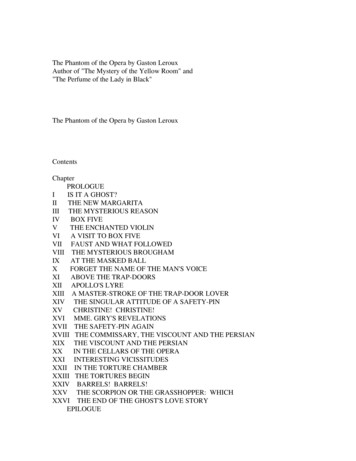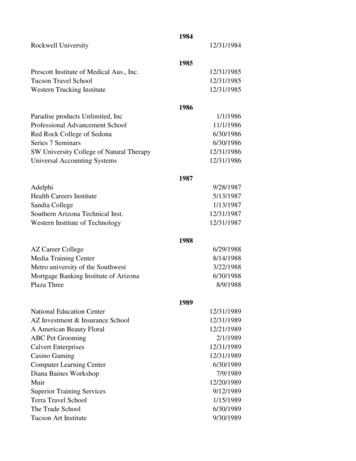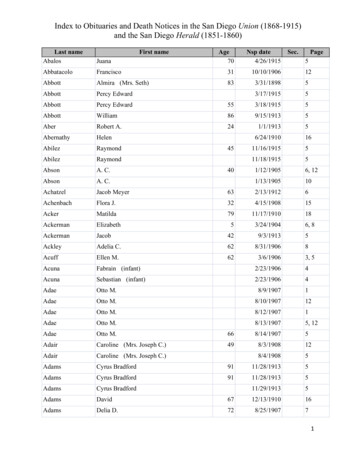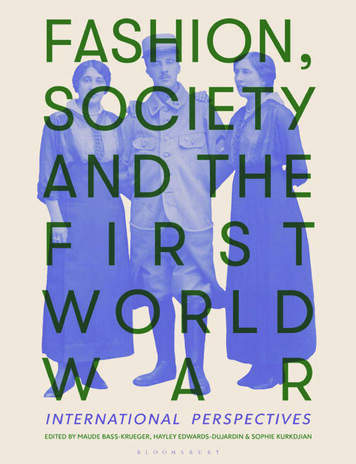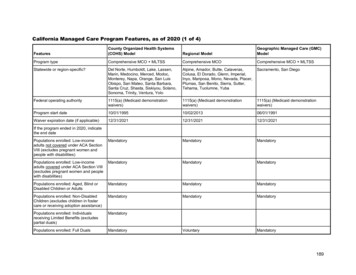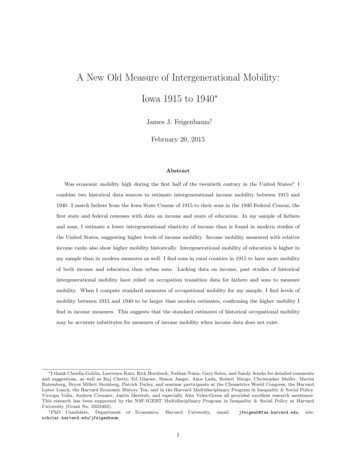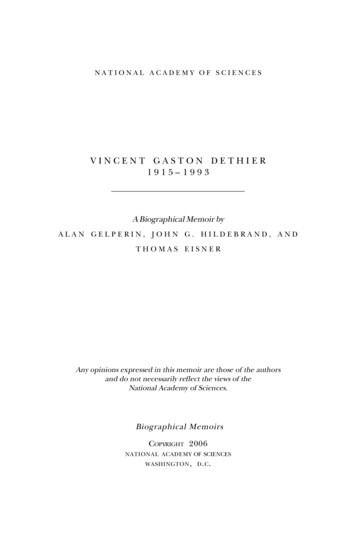
Transcription
NATIONAL ACADEMY OF SCIENCESVINCENT GASTON DETHIER1915– 1993A Biographical Memoir byALAN GELPERIN, JOHN G. HILDEBRAND, ANDTHOMAS EISNERAny opinions expressed in this memoir are those of the authorsand do not necessarily reflect the views of theNational Academy of Sciences.Biographical MemoirsCOPYRIGHT 2006NATIONAL ACADEMY OF SCIENCESWASHINGTON , D . C .
Photograph Courtesy of University of Massachusetts Amherst.
VINCENT GASTON DETHIERFebruary 20, 1915–September 8, 1993BY ALAN GELPERIN, JOHN G. HILDEBRAND, ANDTHOMAS EISNERVINCENT DETHIER WAS A man of many facets—scientist, writer,musician, historian, explorer, and paragon of civility.His interests and activities ranged broadly, from the biophysics of chemosensation and the comparative architecture of renaissance cathedrals, to the ecology of naturalpopulations and the tonal structures of baroque cantatas.Just as it takes a village to raise a child, it took a university—nay, several universities—to provide the depth and diversity of colleagues and coworkers to engage fully Vince’svaried interests in science and the arts.Thanks to his exceptional vitality, Vince paid little heedto advancing years. When he was stricken with his sudden,final illness on September 8, 1993, he was in the classroominaugurating another course for a group of lucky collegestudents, fully 54 years after the start of his teaching career.He was the Gilbert L. Woodside Professor of Zoology at theUniversity of Massachusetts, Amherst, a position that didnot carry a teaching responsibility. Even among his friendsand colleagues, few could believe that Vince was 78 yearsold. He had just returned from a summer spent in his beloved family home in East Blue Hill, Maine, where he wrotemany of his more than 170 scientific papers and 16 books,as well as numerous short stories.
4BIOGRAPHICAL MEMOIRSORIGINS OF A SCIENTISTVince was born on February 20, 1915, on the outskirtsof Boston, Massachusetts. His parents conveyed a rich tradition of, and appreciation for, education, scholarship, andmusic—activities that permeated the family’s household. Hisfather had graduated with first prize in piano from theRoyal Conservatory of Liège, and then emigrated to Americawhere he became a music teacher and church organist andchoirmaster in Norwood, Massachusetts. Vince’s mother, whotraced her lineage from an Irish royal clan, had taught inpublic schools in Boston before she married. This rich intellectual, aesthetic, and spiritual nurture, together with hisextraordinary innate curiosity, prepared Vince for a fatefulencounter with the insect world. He described this epochalevent, which took place in a small park called “the oval,” inan autobiographical essay (Dethier, 1985):My first acquaintance with a live butterfly resulted entirely from the initiative of the butterfly. I had wandered up to the oval late one hot, humid,summer day. The long, slanting rays of the sun illuminated my white shirt.Suddenly, something rocketed across the street, made a few zigzags, andlanded on my shirt, just above the pocket. I stood stock-still and slowlylowered my head to see what it was. There with its wings slowly expandingclung a brown butterfly with a red band extending down each wing. Thisred admiral was the first live butterfly I had ever seen at close range, and Iwas fascinated.Vince never lost that childhood fascination. From thattime on, he collected, reared, and studied butterflies anddeveloped a love for living creatures and their behavior. Inhis early butterfly-rearing efforts, Vince found that all wentwell when he knew which plant was the insect’s preferredfood. He was struck by his observation that some caterpillars starved to death rather than eat nutritious but nonpreferred plants, and he wondered why. As a teenager, heperformed simple behavioral experiments that led him to
VINCENT G. DETHIER5conclude that butterfly larvae possessed keen senses of smelland taste that were vital to their food plant selection. Theseobservations gave early evidence of an independence of spiritand ability to draw important conclusions from simple andelegantly designed experiments. This ability was a recurring theme throughout his scientific career. Captivated byhis early observations on caterpillar food selection, Vincefound his calling even before he entered Harvard College,where he majored in biology with the expectation of becoming a high-school teacher.THE HARVARD YEARSVince’s interest in the natural world survived Harvard’stedious biology courses (rote memorization was de rigueur)and close contact with pickled, rank specimens deliveredfor dissection. Harvard’s tutorial system made all the difference. It was Vince’s good fortune to have as his tutor thephysiologist T. J. B. Stier. Stier not only encouraged hisinterest in caterpillar food-plant selection but also encouraged Vince to prepare his findings for publication. Theresult: a pair of papers (“Gustation and Olfaction in Lepidopterous Larvae” [Dethier, 1937a] and “Cannibalism amongLepidopterous Larvae” [Dethier, 1937b]) that went counterto the established belief that creatures with supposedly simplenervous systems like caterpillars could not possibly possesssophisticated chemosensory abilities. Vince—typically, as timewould prove—broke new ground that would eventually drawwhole contingents of insect sensory physiologists followingin his tracks.When Vince reminisced about his Harvard years, though,it was the adventures with fellow students that he related,not his scientific accomplishments. He and his friends loved,for example, to spend winter break hiking up the slopingbackside of Mount Washington, carrying skis and lunch. It
6BIOGRAPHICAL MEMOIRStook most of the day to reach the summit. Once there, theyexchanged snowshoes for skis, untied and loosened the lacesof their boots (there were no safety bindings at that time),and schussed down the steep front slope. Vince reported,with typical humility, that he never made it all the waydown without a near-catastrophic spill.Vince stayed at Harvard for graduate studies (Ph.D. in1939), during which he pursued his commitment to thestudy of host-plant selection by lepidopterous larvae. Hisadvisor, C. T. Brues, was an expert on insect feeding habits.One of us (A.G.) recalls Vince commenting that one ofBrues’s most attractive features was that he required progressreports only once a year, thereby giving Vince the freedomto exercise his judgment on how best to proceed with hisexperiments. This mentoring style suited Vince perfectly inthe heady atmosphere of the Harvard biology communityof the 1930s. When Vince and his fellow graduate studentsneeded to learn insect physiology and found no courses onthe subject, they organized themselves and taught each other.Among the cadre of fellow students at Harvard at that timewere luminaries including Carroll Williams, who were tobecome leaders in the world of insect study.One of us (A.G.) profited greatly from Vince’s nonauthoritarian mentoring style, first in graduate school asVince’s doctoral student and later as Vince’s junior colleague on the faculty at Princeton.At the time when Vince, at Harvard, was studying thechemical senses of caterpillars, no insect chemoreceptorhad been functionally identified. His behavioral and morphological studies showed him how difficult it was to overcome the technical problems inherent in the study of insect chemoreceptors. After learning of Adrian’s achievementsin electrophysiological exploration of sense organs, Vinceapproached C. Ladd Prosser at Clark University, who was
VINCENT G. DETHIER7applying such techniques to the study of earthworms, onhow one might go about obtaining recordings from insectchemoreceptors. Despite his best efforts during a stimulating summer in Prosser’s laboratory, Vince was unable toachieve the necessary technical breakthroughs. In fact, itwould be more than 15 years before it became possible torecord action potentials from the primary chemoreceptorneurons of insect chemosensillae. The breakthroughs camenone too soon for Vince, who had already decided at thetime of receipt of his Ph.D. to make the study of insectchemoreception his lifetime passion.THE WAR YEARSAfter a brief appointment as a junior faculty memberat John Carroll University in Cleveland, Ohio, Vince joinedthe Army Air Corps in the Africa-Middle East theater ofoperations during World War II. Turning adversity into opportunity, he wrote his first book (Dethier, 1947) in thebomb bay of a B-25 using a captured Italian typewriter.Once, while stationed at an isolated airport, Vince hit upona stratagem for keeping boredom at bay. Through militarychannels and for no reason other than to see what mighthappen, he put through a requisition for “anhydrous water.” In a matter of weeks the requisition came back, enriched by a whole stack of appended forms, plus a requestthat he specify the concentration at which the chemical wasneeded. “Ninety-nine-point-nine percent” was Vince’s reply,which prompted a further query. “What kind of containershould be used?” “Stainless steel,” was Vince’s answer, andso the exchange continued, growing in absurdity and inbureaucratic involvement each step of the way. Vince wassure that he had stirred into action a sizeable fraction ofthe Army Air Corps.
8BIOGRAPHICAL MEMOIRSVince later became liaison officer to the chief of theChemical Warfare Service in Washington, D.C. This broughthim into contact with Kenneth Roeder, arguably the leading insect physiologist in America at the time. On visits toRoeder’s laboratory at Tufts University, Vince saw that greatstrides were being made in insect sensory electrophysiologyand realized that he would himself have to make use of thetechniques involved.In 1946 Vince returned from active duty and joined aresearch group at the Army Chemical Center at Edgewood,Maryland, working with chemicals that affected insect behavior. This group included D. Bodenstein, L. Chadwick,H. Frings, and C. C. Hasset. Their early attempts to relatechemical structure to stimulating effectiveness matchedVince’s interests perfectly. At Edgewood he began his research partnership with the black blowfly, Phormia regina,and continued his quest to understand the transductionmechanism of insect chemoreceptors. Stimulating the tarsal taste hairs of a hungry Phormia elicited reflex proboscisextension, which then served as a quantitative index of stimulating effectiveness of a taste solution. By using very largeseries of sugars, alcohols, acids, and inorganic salts, Vincebegan to define the molecular requirements for the binding sites on the chemoreceptors providing input to the proboscis extension reflex. These molecular insights from behavioral studies would later prove invaluable when it becamepossible to make electrophysiological recordings from thetaste cells that populate fly taste hairs.THE HOPKINS YEARSAfter his brief but inspiring research stint at the ArmyChemical Center, Vince accepted a professorship of zoology and entomology at Ohio State University. A year afterestablishing himself in Columbus, he startled his friends by
VINCENT G. DETHIER9resigning this tenured position to accept a nontenured postas associate professor at Johns Hopkins University. The yearsat Hopkins (1947-1958), he later said, were among the mostproductive, educational, and adventuresome of his career.He was part of a group of neuroscientists and physiologicalpsychologists who shared his broad perspective and appreciation for multiple approaches to animal behavior and itsneural mechanisms. Notable among these Hopkins colleagueswas Eliot Stellar, who later moved to the University of Pennsylvania and spearheaded a successful drive to lure Vince toPhiladelphia.A major breakthrough in the study of insect chemoreceptors occurred when Vince’s first graduate student, E. S.Hodgson, during a postdoctoral stint with K. D. Roederand with assistance from J. Lettvin at the Massachusetts Institute of Technology, developed an electrophysiological technique for recording the responses of single chemosensoryneurons to aqueous stimuli applied to the tip of the tastehair (Hodgson et al., 1955). This tip-recording method ledto a seminal series of papers characterizing the responsesof single cells in taste hairs of Phormia and later, with L.Schoonhoven, of caterpillars. Vince had shown in behavioral experiments with Phormia that a taste solution elicited the proboscis extension reflex only when the tastantcontacted the tip of the taste hair. Now he could listen inon the neural responses of the small set of contact chemoreceptor neurons associated with dendrites in the hollow channel of taste hairs.A neuroethologist by instinct, Vince considered at every turn the nature of the stimuli encountered by fly chemoreceptors in the natural world. This led him to use as tastestimuli a wide array of substances, many derived from leafsurfaces, rather than just the salt, sweet, sour, and bittercompounds commonly used in studying vertebrate chemore-
10BIOGRAPHICAL MEMOIRSception. As the range of chemostimuli broadened, the picture of the taste code became more complex, even as viewedfrom the limited repertoire of sensory cells in a single Phormiataste hair. Vince grappled with the complexities of chemosensory coding with characteristic concern for the Umwelt orsensory world of the fly. (The issue of taste coding in insects is still an active area of research and debate, as it is inmammalian taste coding.)THE PHILADELPHIA YEARSVince moved to the University of Pennsylvania in 1958,joining several of his former Hopkins colleagues in the Institute of Neurological Sciences in the School of Medicine.While Vince’s primary appointment was in the biology department, the interdepartmental and interdisciplinary assemblage of behavioral scientists, neuroscientists, and physiological psychologists gathered in the Institute of NeurologicalSciences was a lively and intense group that provided eachparticipant with widely ranging perspectives and technicalapproaches. In this milieu, Vince and his colleague EliotStellar wrote the landmark book, Animal Behavior (1961),which appeared in three editions and ten languages.Among the issues with which Vince and others grappledduring weekly seminars was motivation. Was it a useful concept? Was it a general concept? Do insects have motivation?Some argued that this behavior separated invertebrates fromvertebrates, thereby providing a basis for excluding insects,but in due course Vince performed experiments showingclearly that insects had that key feature. While some ofVince’s colleagues found this exasperating, their mutualrespect overcame their disagreements. These heated exchanges were educational for the cadre of graduate students in attendance, who learned from the debates that
VINCENT G. DETHIER11disagreements in the realm of science need not in any wayaffect the bonds of friendship.Vince was renowned for his wit and charm. At a memorably bombastic departmental faculty meeting, passions ranhigh over opinions strongly held. Among the actors in thisdrama was the department chair, whose normal speakingvoice could reverberate across campus, and who reportedlyhad the shortest fuse in the history of the university. As theverbal exchange heated up, Vince (himself quite feisty)couldn’t resist a few rapier thrusts. “Vince, only an ass wouldsay that,” the chairman bellowed. “Yes, Mr. Chairman, Iknow that,” replied Vince, “but I thought you were about tosay it, and I wanted to save you the embarrassment.” Themeeting erupted in laughter and the two men departed thebest of friends.The Philadelphia years marked advances in understanding the response properties of fly gustatory receptors andthe regulation of feeding in the fly. The students involvedin this work included Frank Hanson, Joseph Larsen, Margaret Nelson, and many others, including one of us (A.G.).The work on Phormia was collected in Vince’s magnumopus, The Hungry Fly, published in 1976, which makes clearthat our understanding of fly feeding behavior is more complete than for any other species then under study. (Whilethis is still the case, the mammals are advancing.) Withpostdoctoral associates Louis Schoonhoven from the Netherlands and Tibor Jermy from Hungary, Vince was able atlast to carry out a detailed electrophysiological analysis ofcaterpillar chemoreceptors, as he had long yearned to do.THE PRINCETON YEARSVince moved to the biology department at PrincetonUniversity in 1967, to take up an endowed chair. There, hiselectrophysiological investigations of flies and caterpillars
12BIOGRAPHICAL MEMOIRScontinued apace, yielding evidence of the importance ofboth labeled-line and across-fiber coding in the gustatorypathways of insects. Vince’s devotion to insect-plant interactions and chemosensory function was undiminished aftermore than 30 years of work.When one of us (A.G.) joined the biology faculty ofPrinceton in 1968, Vince was as supportive as he had beenas a “doctor father,” even as his former student’s researchturned from insects to mollusks. Vince, as so many were tolearn on their own, was in every respect an ideal colleague.At Princeton, Vince returned to his interest in learning in flies. The lack of evidence for learning in these insects led Vince to speculate in a remarkable paper entitled“Microscopic Brains” (Dethier, 1964) that perhaps flies couldnot learn. Two developments were later to prove otherwise.In 1974 Chip Quinn, Bill Harris, and Seymour Benzer published a demonstration of odor-conditioned behavior inDrosophila (Quinn et al., 1974). About 10 years later, T.Fukushi showed reliable and robust one-trial color-food conditioning in walking flies (Fukushi,1985). Ironically, thewalking flies learned the food-color association as they didthe search “dance” that Vince described in his 1964 paper.The molecular dissection of fly learning continues to be amajor research topic in neuroscience.Vince also tested the idea that polyphagous caterpillarswould be more likely to show food-aversion conditioningthan monophagous caterpillars, a suggestion one of us (A.G.)made in a paper on comparative aspects of food-aversionconditioning. Vince found that one species of polyphagouscaterpillar did show such conditioning, while a species ofmonophagous caterpillar did not.The phenomenon of learning completes a picture inwhich food selection behavior comprises three-tiers: (1) aperipheral system, sensitive to multiple chemical stimuli;
VINCENT G. DETHIER13(2) an internal chemosensory system that measures the qualityand quantity of absorbed food constituents and which maymodify the insect’s behavior via its input to the central nervous system; and (3) a modifiable integrative center in thecentral nervous system that decodes sensory patterns andcommands the feeding motor-control center, integratingfeedback from previous postingestive consequences associated with responses to a chemosensory code.Vince was at the forefront of the scientific endeavor tounravel food selection behavior in herbivorous insects. Heset his enduring mark on the basics of the first two components of the three-tiered system. The third component, thebrain, remains even now terra incognita. Analyzing it willnot be an easy task, although recent progress in unravelingkey aspects of how insects process olfaction, vision, andaudition provides encouragement.THE AMHERST YEARSVince increasingly heard the call of two of his lifelongpassions—his beloved summer home in East Blue Hill, Maine,and his avocation as a creative writer. He dreamed of earlyretirement, of living in Maine and building on his alreadyestablished success as a celebrated writer. But with Jehanand Paul, the children of his midlife marriage to Lois Crow,still in college, it was not to be. Instead, in 1975 Vincemade a last move, this time to assume the Gilbert L. WoodsideProfessorship of Biology at the University of Massachusettsin Amherst.Established in his new laboratory, joined by postdoctoralassociates Elizabeth Bowdan, Mary Behan, and RobertoCrnjar, and reunited with Martha Yost, who had been hisfirst research assistant at Hopkins and who now lived inAmherst, Vince redoubled his efforts to crack the gustatorycode in caterpillars. His prefatory chapter in the Annual
14BIOGRAPHICAL MEMOIRSReview of Neuroscience for 1990 summarizes his long history of work in chemosensory neuroscience during a timeof transition from descriptive to functional studies, alongwith more philosophical comments on the nature of realityand comprehension made possible by our sensory receptors and filtered by our contemporary intellectual ambience (Dethier, 1990).His new position was a research professorship, and Vinceintended to focus exclusively on his research program, butevents distracted him from unfettered focus on research.The university needed his leadership and humanitariantouch—first to serve as founding director of the new Neuroscience and Behavior Program, and later, during a particularly unsettled period in the university’s history, to chairthe Chancellor’s Commission on Civility (Dethier, 1984).At the same time, the university began a series of coursesheavily emphasizing writing skills. Appealing to his love ofclear and elegant exposition, Vince found that teachingwas a commitment he couldn’t break.To acknowledge his accomplishments on the Commission on Civility and his strong commitment to civility issuesgenerally, the university established posthumously the VincentDethier Award for the faculty member who best exemplifiesthe ideals to which Vince aspired. For an academic whosecivility was intrinsic to his very nature, this may indeed bethe ultimate accolade.BEYOND THE REALM OF SCIENCEVince wrote a number of evocative and lyrical bookson natural history, including To Know a Fly (1976), TheTent Makers (1980), The Ecology of a Summer House (1962),and Crickets and Katydids, Concerts and Solos (1992). Healso wrote celebrated books for children (Fairweather Duck[1970] and Newberry, The Life and Times of a Maine Clam
VINCENT G. DETHIER15[1981]) and satires (including Buy Me a Volcano [1972]and The Ant Heap [1979]).In Newberry Dethier showed his talents as a storytellerpar excellence. During summers with the family in Maine,he observed and absorbed in great detail the world of creatures on the surrounding coastal shores. He portrayed thisworld with warmth and wit in the daily adventures of a clamnamed Newberry, to whom a local doctor gave a purplewoolen muffler to tie around his long neck to cure an ache.Newberry’s adventures and involvements bring alive, andcharmingly so, the essential biology of many shore creatures, from clams and starfish to sandpipers and gulls.Vince’s short story “The Moth and the Primrose”(Dethier, 1980) was selected for inclusion in The Best American Short Stories of 1981, one of several awards Vince received for his varied works of fiction. In part a poetic lessonin insect-plant interactions, the story is a moving tale ofOld Prout, a clam digger, “one of the least of all creatures”who did “great good simply because he did no harm. Yet insimply living his life he affected the lives of all others.”Prout built a road across a peninsula or, rather, “by use hehad created the road. Although he did not know it, withthe road he had made possible a whole cosmos. He hadmade possible the primroses. Without the road, there wouldhave been none because they grew nowhere else. Withoutthe primroses, there would have been no moths becausethey too could exist nowhere else.” In this bittersweet tale,Vince portrays the interwoven lives of Prout, the primroses,and the moths. No account here could possibly capture thedepth of understanding for the flowering and ebbing oflife nor the pathos expressed in this story. Prout died onenight in a violent storm; without him, the road graduallydisappeared, and with it went the primrose and the moths.At the burial the parson pondered the meaning of the old
16BIOGRAPHICAL MEMOIRShermit’s life. Being ignorant of the interplays of natureProut made possible, the parson would not understand that“in some unfathomable manner Prout was perfected in thebeing of the moth and the primrose. Perhaps it was rightthat all these things ceased in time to exist after the oldman had gone. For nothing really survives the man . . . atrace perhaps, a pyramid, a web; but these must be emptysymbols.”Particularly notable among these works that intertwineliterature and philosophy is Ten Masses, in which Vincegives voice to his personal philosophy and the role of faithin his life. Vince could have been a poster child for StephenJay Gould’s Principle of NOMA—“Non-Overlapping Magisteria.” Critical scientific thought and religious faith belongto distinct “magisteria,” or domains of knowledge, Gouldsays; they are not mortal enemies. We do not know whatVince would have said on this issue, but his life and writings are a testament to the potential creative synergy ofthese two magisteria.Vince’s exceptional qualities as a scientist of breadth,insight, and creativity, as an inspiring and beloved teacher,as a masterful writer, and as a gentleman of good humor,generosity, and uncommon yet natural civility endeared himto everyone who knew him and brought him richly deservedrecognition. Among his many honors were election to theAmerican Academy of Arts and Sciences (1960), The National Academy of Sciences (1965), and the American Philosophical Society (1980); membership in the Explorers Club;and fellowship in the Royal Entomological Society of London. In 1993 he received the John Burroughs medal fordistinguished nature writing.Of the many honors he received and meetings he attended, the yearly gathering of fellows of the American Philosophical Society, rich with artists, authors, musicians, and
VINCENT G. DETHIER17scientists, held a special attraction. At his inaugural meeting in 1980, he found great delight in having lunch with afellow inductee, the opera singer Beverly Sills. His addressto the members, “Sniff, Flick and Pulse: An Appreciation ofInterruption” (Dethier, 1987), was vintage Vince, weavingtogether how the principles of sensory perception and biophysics, elucidated in the realm of odor perception, aredirectly tied to human perception and the appreciation ofart, architecture, and music.Vincent Gaston Dethier was loved—and is remembered—for his passion for nature, his elegant science, his deepdesire to understand, and his dedication to lucid and esthetic communication of that understanding; for his friendlymanner, keen wit, lively sense of humor, and love of family;and for his humanity. In her contribution to theFestschrift honoring Dethier on his seventieth birthday,Miriam Rothschild gave voice to these feelings in her ownperfect and inimitable way. Referring to a painting by VanGogh, she wrote:Two White butterflies twirling in freedom and winged delight. For me theyare the symbol of daydreaming—the poetry that Vince Dethier insinuatesso cunningly into our factual information and knowledge. For the gift, ofthese special white butterflies—along with all your official and unofficialstudents, past, present, and future—Vince Dethier, I tender you my mostheartfelt and grateful thanks (Chapman et al., 1987).
18BIOGRAPHICAL MEMOIRSREFERENCESChapman, R. F., E. A. Bernays, and J. G. Stoffolano Jr. 1987. Perspectives in Chemoreception and Behavior. New York: SpringerVerlag.Dethier, V. G. 1937a. Gustation and olfaction in lepidopterous larvae. Biol. Bull. 72:7-23.Dethier, V. G. 1937b. Cannibalism among lepidopterous larvae. Psyche44:110-115.Dethier, V. G. 1947. Chemical Insect Attractants and Repellents.Philadelphia: Blakiston Press.Dethier, V. G. 1964. Microscopic brains. Science 143:1138-1145.Dethier, V. G. 1980. The moth and the primrose. Mass. Rev. 21:23253.Dethier, V. G. 1984. A University in Search of Civility. Amherst,Mass.: Inst. Govt. Service, University of Massachusetts.Dethier, V. G. 1985. Curiosity, milieu, and era. In Leaders in theStudy of Animal Behavior: Autobiographical Perspectives, ed. D.A. Dewsbury, pp 42-67. Lewisburg, Pa.: Bucknell University Press.Dethier, V. G. 1987. Sniff, flick, and pulse: An appreciation of interruption. Proc. Am. Philos. Soc. 131:159-176.Dethier, V. G. 1990. Chemosensory physiology in an age of transition. Annu. Rev. Neurosci. 13:1-13.Fukushi, T. 1985. Visual learning in walking blowflies, Lucilia cuprina.J. Comp. Physiol. A 157:771-778.Hodgson, E. S., J. Y. Lettvin, and K. D. Roeder. 1955. Physiology ofa primary chemoreceptor unit. Science 122:417-418.Quinn, W. G., W. A. Harris, and S. Benzer. 1974. Conditioned behavior in Drosophila melanogaster. Proc. Natl. Acad. Sci. U. S. A.71:708-712.
VINCENT G. DETHIER19SELECTED BIBLIOGRAPHY1941The function of the antennal receptors in lepidopterous larvae.Biol. Bull. 80:403-4141942The dioptric apparatus of lateral ocilli. I. The corneal lens. J. Cell.Comp. Physiol. 19:301-313.1947With L. E. Chadwick. Rejection thresholds of the blowfly for a seriesof aliphatic alcohols. J. Gen. Physiol. 30:247-253.1950With C. C. Hassett and J. Gans. A comparison of nutritive value andtaste thresholds of carbohydrate for the blowfly. Biol. Bull. 99:4464531951The limiting mechanism in tarsal chemoreception. J. Gen. Physiol.35:55-65.1954Evolution of feeding preferences in phytophagous insects. Evolution 8:33-54.With M. V. Rhoades. Sugar preference-aversion functions for theblowfly. J. Exp. Zool. 126:177-204.With C. T. Grabowski. The structure of the tarsal chemoreceptorsof the blowfly, Phormia regina Meigen. J. Morphol. 94:1-19.1955The physiology and histology of the contact chemoreceptors of theblowfly. Q. Rev. Biol. 30:348-371.1956Some factors controlling the ingestion of carbohydrates by the blowfly.Biol. Bull. 111:204-222.
20BIOGRAPHICAL MEMOIRS1957Communication by insects: physiology of dancing. Science 125:331336.1958With D. Bodenstein. Hunger in the blowfly. Z. Tierpsychol.
VINCENT GASTON DETHIER February 20, 1915-September 8, 1993 BY ALAN GELPERIN, JOHN G. HILDEBRAND, AND . inaugurating another course for a group of lucky college students, fully 54 years after the start of his teaching career. . his early butterfly-rearing efforts, Vince found that all went
